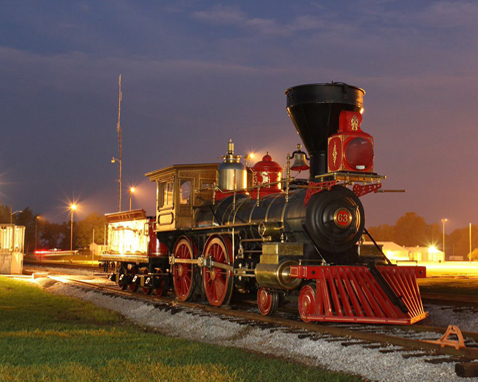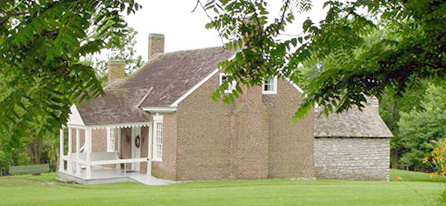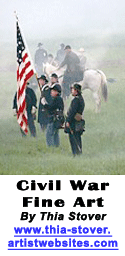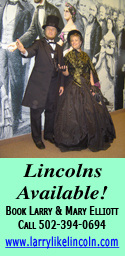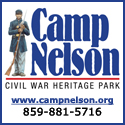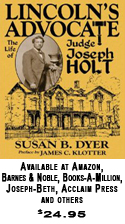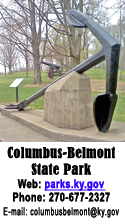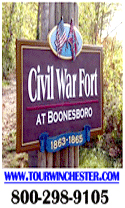|
600 were ‘pulled back’ to Civil War,
thanks to Bluegrass Railroad Museum
Who says you can’t be “pulled back” to the Civil War era?
On Labor Day, that’s what some 600 railroad enthusiasts experienced as they boarded a train powered by an 1860s-era steam locomotive.
The engine, named the Leviathan 63, is a full-scale replica of the locomotive that powered Abraham Lincoln’s funeral train from Washington City to his burial site in Springfield, Ill., in April and May 1865. Read more
McConnell joins Rogers in effort
to put Mill Springs in park system
U.S. Senate Minority Leader Mitch McConnell has joined U.S. Rep. Hal Rogers in introducing legislation to make Mill Springs Battlefield part of the national park system.
McConnell’s Sept. 9 legislation directs the U.S. Secretary of the Interior to evaluate a proposal to include the battlefield as a national park. Such a feasibility study by the Kentucky legislators makes a final national park designation easier to achieve. Rogers successfully introduced and backed identical legislation earlier this year in the U.S. House.
Read more
2nd Kentucky Cavalry was participant
in largest troop surrender of Civil War
Men from the 2nd Kentucky Cavalry were on hand in April 1865 for what has been called the largest troop surrender of the Civil War.
It also is called the event that effectively ended the War Between the States.
The surrender occurred as Confederate Gen. Joseph E. Johnston met Union Gen. William T. Sherman at an unassuming farmhouse near present-day Durham, N.C., where they signed documents to end fighting by Southern armies in the Carolinas, Georgia and Florida. Read more
Kentucky’s Civil War leaders…
Charles Mynn Thruston was frustrated
in protecting railroad from Rebel raiders
(EDITOR’S NOTE: This is the 30th in a series about Kentucky’s officers and battle leaders during the Civil War.)
Charles Mynn Thruston, a Union brigadier general, probably was one of the more frustrated residents of Maryland during the Civil War.
The Lexington, Ky., native, was serving as mayor of Cumberland, Md., a critical railroad hub, when the Civil War began. He had resigned his commission in the army in 1836 to become a farmer in the Old Line State. Read more
Famous helping hand was required
to save life of another Lincoln
A helping hand sometimes can save a life.
It did at least for Robert Todd Lincoln, the oldest son of President Abraham Lincoln.
Robert was standing on a crowded train platform in Jersey City, N.J., early in 1864 as passengers were purchasing sleeping car places. After making their purchases, passengers were pushing their way into the car.
“There was some crowding,” young Lincoln recalled, “and I happened to be pressed by it against the car body while waiting my turn. In this situation the train began to move, and by the motion I was twisted off my feet, and had dropped somewhat, with feet downward, into the open space, and was personally helpless.”
Read more
Morgan took McMillan’s Landing
at Tompkinsville as first raid began
(EDITOR’S NOTE: Chad Comer was a major contributor to this account of the Battle of Tompkinsville.)
McMillan’s Landing was a key point.
The Monroe County location was the crossing point for both Union and Confederate troops to make their way to Kentucky from Tennessee.
Both forces viewed Monroe County and Tompkinsville as a key position in 1862 to hold for entry to central Kentucky and points northward.
Read more
Southern march acreage may be added
to land saved at Richmond Battlefield
In November 2001, a 62-acre tract central to the Battle of Richmond was purchased at auction.
That purchase led to the formation of the Battle of Richmond Association (BORA) and efforts began in earnest to obtain more of the property where the Aug. 29-30, 1862 conflict was fought.
Three more acres may soon be added to the battle’s hallowed grounds, which would boost the total acreage saved to approximately 700.
Read more
|
|
|
According to D.F. Faulds…
Louisville’s Hays, not Emmett, wrote
lyrics of South’s national anthem, ‘Dixie’
By BRYAN BUSH
Bugle Staff Writer
Who wrote the lyrics to “Dixie?”
Most sources credit Daniel Decatur Emmett, an Ohioan, with developing the words and music of what became known as the Southern National Anthem.
But the message of one of the most distinctively American songs of the 19th century may have derived from Louisvillian William Shakespeare Hays, one of the most famous and prolific songwriters of the 1800s. Read more
Recent confrontations weren’t only ones
creating stress disorders; so did Civil War
In World War I, it was called “shell shock.”
World War II described it as “combat fatigue.”
The Civil War didn’t identify it, but according to a recent book, what we now call Post-Traumatic Stress Disorder, or PTSD, was very common during the War Between the States.
Author Eric T. Dean Jr. deals with the problem in his 1997 book, “Shook Over Hell, Post-Traumatic Stress, Vietnam, and the Civil War.”
Read more
Fighting on empty stomach possible,
but both sides needed coffee as fuel
An army may fight on its stomach, but in the Civil War something else may have been paramount. Coffee.
For Union soldiers and fortunate Confederates who could scrounge some, coffee fueled the war. Soldiers drank it before marches, after marches, on patrol, during combat.
Union troops made their coffee everywhere and with everything: with water from canteens and puddles, brackish bays and Mississippi mud, liquid their horses would not drink. They cooked it over fires of plundered fence rails, or heated mugs in scalding steam-vents on naval gunboats. When times were good, coffee accompanied beefsteaks and oysters; when they were bad it washed down raw salt-pork and maggoty hardtack. Coffee was often the last comfort troops enjoyed before entering battle, and the first sign of safety for those who survived.
Read more
Switch from Union to Confederate
delayed Jessamine County memorial
With the outbreak of the Civil War, many U.S. soldiers – including Robert E. Lee – switched allegiances to the Confederacy.
A Jessamine County courthouse figure probably was among the last to do so. Some 35 years after the war ended, a monument featuring a seven-foot-tall soldier cast in bronze was dedicated at Nicholasville on June 15. Read more
One of good things Civil War provided
was knowledge, use of modern anesthesia
Although it was the bloodiest conflict in American history, there were some good things that resulted from the Civil War.
The development of the telegraph improved communications tremendously. It was found that railroads provided better transportation and that photography was a great way to record history. Where sustenance was concerned, it was learned that tin cans allowed food to be shipped longer distances without spoiling.
From a medical standpoint, ambulances and hospitals were developed, the importance of sanitation and hygiene began to be understood and the value of anesthesia in reducing the mortality rate was discovered the hard way. Patients who were anesthetized appeared to survive. Those who weren’t, often didn’t.
Read more
Bennett Young took over St. Albans,
brought Civil War to New England
A tall stranger, mistaken for a minister, dismounted and drew a brace of pistols.
“Gentlemen,” he said, “I’m a Confederate officer and my men have come to take your town. Anyone who resists will be shot.”
That began a well-planned robbery as small groups of Confederate raiders were entering three banks in St. Albans, Vt., and taking what later was declared to be more than $200,000 in gold and silver coin, greenbacks and bank securities. Read more
Bugle Briefs...
Middle Creek, Perryville featured
as prominent Southern battlefields
The Battle of Middle Creek and the Perryville Battlefield were two Kentucky sites featured in a recent USA Today article about Civil War battlegrounds in the South.
Neal Turnage wrote, “it’s impossible to deny the compelling narrative the Civil War still weaves into the culture of the South. A visit to former battlegrounds and sites where the war played out offers the visitor a gateway into why the issue remains important.”
He noted that Prestonsburg and Perryville were “tickets to that history and its present day resonance.” Read more
|
|
|


